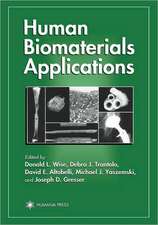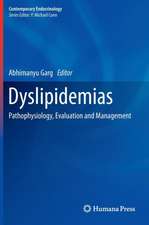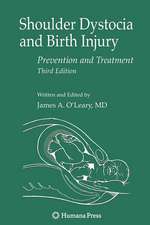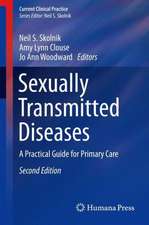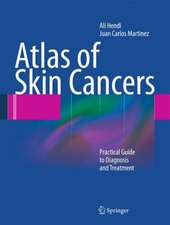Hyperlipidemia in Primary Care: A Practical Guide to Risk Reduction: Current Clinical Practice
Editat de Matthew J. Sorrentinoen Limba Engleză Paperback – 4 aug 2011
Din seria Current Clinical Practice
- 5%
 Preț: 1022.66 lei
Preț: 1022.66 lei - 5%
 Preț: 763.43 lei
Preț: 763.43 lei - 5%
 Preț: 1106.50 lei
Preț: 1106.50 lei - 5%
 Preț: 784.75 lei
Preț: 784.75 lei - 5%
 Preț: 787.58 lei
Preț: 787.58 lei - 5%
 Preț: 1321.19 lei
Preț: 1321.19 lei - 5%
 Preț: 583.95 lei
Preț: 583.95 lei - 5%
 Preț: 644.28 lei
Preț: 644.28 lei - 5%
 Preț: 357.77 lei
Preț: 357.77 lei - 5%
 Preț: 1287.38 lei
Preț: 1287.38 lei - 5%
 Preț: 780.40 lei
Preț: 780.40 lei - 5%
 Preț: 1112.70 lei
Preț: 1112.70 lei - 5%
 Preț: 716.28 lei
Preț: 716.28 lei - 5%
 Preț: 752.78 lei
Preț: 752.78 lei - 5%
 Preț: 1111.98 lei
Preț: 1111.98 lei - 5%
 Preț: 656.26 lei
Preț: 656.26 lei - 5%
 Preț: 704.99 lei
Preț: 704.99 lei - 5%
 Preț: 1115.28 lei
Preț: 1115.28 lei - 5%
 Preț: 714.46 lei
Preț: 714.46 lei - 5%
 Preț: 1175.99 lei
Preț: 1175.99 lei - 5%
 Preț: 1404.00 lei
Preț: 1404.00 lei - 5%
 Preț: 1107.94 lei
Preț: 1107.94 lei - 5%
 Preț: 1104.32 lei
Preț: 1104.32 lei - 5%
 Preț: 373.84 lei
Preț: 373.84 lei - 5%
 Preț: 363.44 lei
Preț: 363.44 lei - 5%
 Preț: 1113.63 lei
Preț: 1113.63 lei - 5%
 Preț: 717.20 lei
Preț: 717.20 lei - 5%
 Preț: 648.62 lei
Preț: 648.62 lei - 18%
 Preț: 1667.28 lei
Preț: 1667.28 lei - 5%
 Preț: 720.02 lei
Preț: 720.02 lei - 5%
 Preț: 363.79 lei
Preț: 363.79 lei - 5%
 Preț: 721.77 lei
Preț: 721.77 lei - 5%
 Preț: 793.79 lei
Preț: 793.79 lei
Preț: 712.60 lei
Preț vechi: 750.11 lei
-5% Nou
Puncte Express: 1069
Preț estimativ în valută:
136.37€ • 141.51$ • 113.98£
136.37€ • 141.51$ • 113.98£
Carte tipărită la comandă
Livrare economică 15-29 martie
Preluare comenzi: 021 569.72.76
Specificații
ISBN-13: 9781603275019
ISBN-10: 1603275010
Pagini: 300
Ilustrații: XI, 300 p. 13 illus., 5 illus. in color.
Dimensiuni: 155 x 235 x 15 mm
Greutate: 0.34 kg
Ediția:2011
Editura: Humana Press Inc.
Colecția Humana
Seria Current Clinical Practice
Locul publicării:Totowa, NJ, United States
ISBN-10: 1603275010
Pagini: 300
Ilustrații: XI, 300 p. 13 illus., 5 illus. in color.
Dimensiuni: 155 x 235 x 15 mm
Greutate: 0.34 kg
Ediția:2011
Editura: Humana Press Inc.
Colecția Humana
Seria Current Clinical Practice
Locul publicării:Totowa, NJ, United States
Public țintă
Professional/practitionerCuprins
1. Cardiovascular Risk Assessment.- 2. The Metabolic Syndrome.- 3. The Role of Imaging in Cardiovascular Risk Assessment.- 4. Inherited Lipoprotein Disorders.- 5. Advanced Lipid Testing.- 6. Therapeutic Lifestyle Change for the Prevention and Treatment of Hyperlipidemia and Coronary Artery Disease.- 7. Drug Therapy for Dyslipidemia.- 8. Hypertriglyceridemia.- 9. Isolated Low HDL.- 10. Lipoprotein(a).- 11. HIV with Dyslipidemia.- 12. Treatment of Dyslipidemia in Patients with Renal Insufficiency and End-Stage Renal Disease.
Recenzii
From the reviews:
“This is one of a number of books addressing the single topic of hyperlipidemia. The strength of this one lies in its extensive literature review and analysis. … While this book is aimed at clinicians who commonly treat patients with hyperlipidemia, it is so well organized and easy to understand that it will be useful for laypersons who have been diagnosed with some component of hyperlipidemia … . I highly recommend this book to all who treat patients with dyslipidemia.” (Vincent F. Carr, Doody’s Book Reviews, November, 2011)
“This is one of a number of books addressing the single topic of hyperlipidemia. The strength of this one lies in its extensive literature review and analysis. … While this book is aimed at clinicians who commonly treat patients with hyperlipidemia, it is so well organized and easy to understand that it will be useful for laypersons who have been diagnosed with some component of hyperlipidemia … . I highly recommend this book to all who treat patients with dyslipidemia.” (Vincent F. Carr, Doody’s Book Reviews, November, 2011)
Textul de pe ultima copertă
Cardiovascular disease is the number one cause of death for men and women in this country, surpassing deaths due to all cancers combined. Better awareness of heart disease risk factors and improved treatment modalities has produced great progress in reducing deaths due to myocardial infarction and stroke over the past few decades. Still, more progress is needed, as about half of all first coronary events occur in individuals who have no cardiac symptoms and no previously diagnosed heart disease. The primary care physician, therefore, has an important role in identifying at risk individuals and beginning preventive modalities. In Hyperlipidemia in Primary Care: A Practical Guide to Risk Reduction, a group of leading authorities in the field offers a comprehensive overview of the problem along with practical strategies for treating it. This unique title reviews methods for assessing risk in patients, including an important and thorough discussion of the Framingham algorithmand its limitations and advantages in assessing CVD risk. The book also reviews the evolving world of lipidology and how to apply many of the newer lipid tests to patients in daily practice, putting these tests into proper perspective and offering a rational approach to using them in practice. Finally, treatment issues are covered. As treatment has expanded to more risk groups, a number of different guidelines have been published with recommended lipid goals. This is an evolving area of research with rapidly changing guidelines that are expanding the pool of high risk patients. An invaluable reference that offers a reasonable approach to risk assessment and treatment of individuals at increased cardiovascular risk, Hyperlipidemia in Primary Care: A Practical Guide to Risk Reduction provides the background needed to make scientifically based decisions that can ultimately help greatly reduce the number of patients impacted by cardiovascular disease.
Caracteristici
State of the art, comprehensive overview of hyperlipidemia and risk assessment Offers unique insights into use of risk estimate data derived from Framingham Heart Study Written by leading authorities in the field Includes supplementary material: sn.pub/extras




